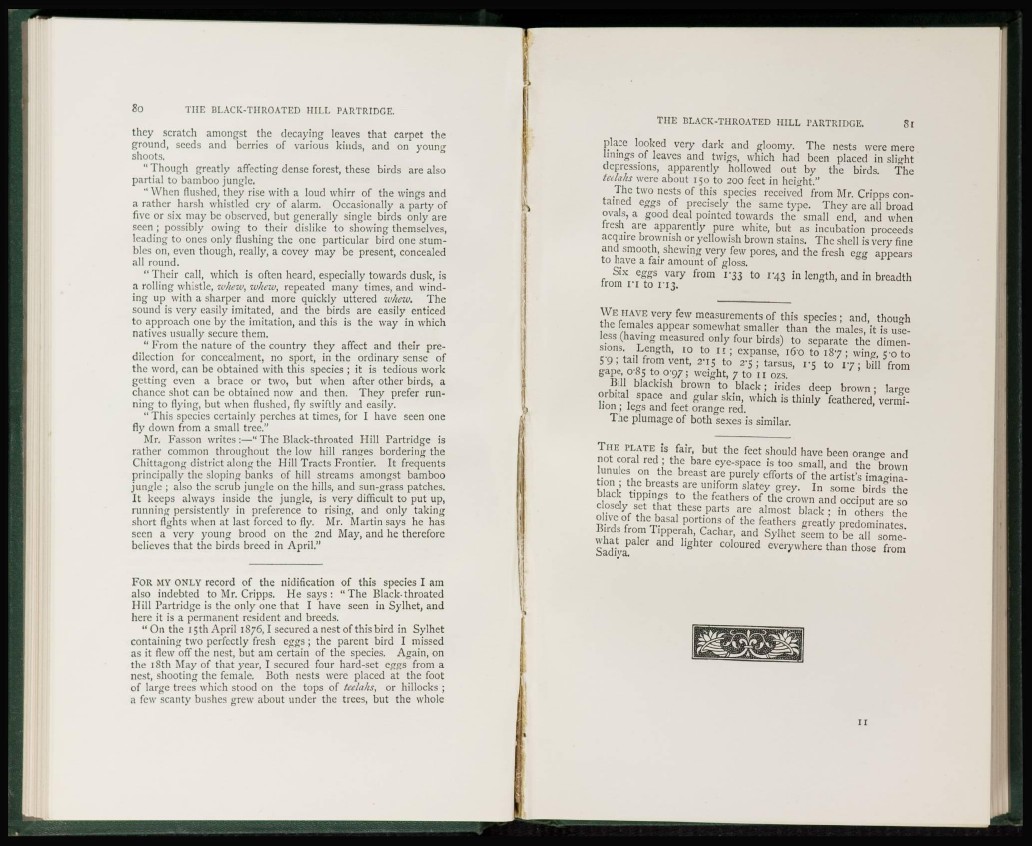
8o THE BLACK-THROATED HILL PARTRIDGE.
they scratch amongst the decaying leaves that carpet the
ground, seeds and berries of various kinds, and on young
shoots.
" Though greatly affecting dense forest, these birds are also
partial to bamboo jungle.
" When flushed, they rise with a loud whirr of the wings and
a rather harsh whistled cry of alarm. Occasionally a party of
five or six may be observed, but generally single birds only are
seen ; possibly owing to their dislike to showing themselves,
leading to ones only flushing the one particular bird one stumbles
on, even though, really, a covey may be present, concealed
all round.
" Their call, which is often heard, especially towards dusk, is
a rolling whistle, whew, whew, repeated many times, and winding
up with a sharper and more quickly uttered whew. The
sound is very easily imitated, and the birds are easily enticed
to approach one by the imitation, and this is the way in which
natives usually secure them.
" From the nature of the country they affect and their predilection
for concealment, no sport, in the ordinary sense of
the word, can be obtained with this species ; it is tedious work
getting even a brace or two, but when after other birds, a
chance shot can be obtained now and then. They prefer running
to flying, but when flushed, fly swiftly and easily.
" This species certainly perches at times, for I have seen one
fly down from a small tree."
Mr. Fasson writes :—" The Black-throated Hill Partridge is
rather common throughout the low hill ranges bordering the
Chittagong district along the Hill Tracts Frontier. It frequents
principally the sloping banks of hill streams amongst bamboo
jungle ; also the scrub jungle on the hills, and sun-grass patches.
It keeps always inside the jungle, is very difficult to put up,
running persistently in preference to rising, and only taking
short fights when at last forced to fly. Mr. Martin says he has
seen a very young brood on the 2nd May, and he therefore
believes that the birds breed in April."
FOR MY ONLY record of the nidification of this species I am
also indebted to Mr. Cripps. He says: "The Black-throated
Hill Partridge is the only one that I have seen in Sylhet, and
here it is a permanent resident and breeds.
"On the 15th April 1876,1 secured a nest of this bird in Sylhet
containing two perfectly fresh eggs ; the parent bird I missed
as it flew off the nest, but am certain of the species. Again, on
the 18th May of that year, I secured four hard-set eggs from a
nest, shooting the female. Both nests were placed at the foot
of large trees which stood on the tops of teelahs, or hillocks ;
a few scanty bushes grew about under the trees, but the whole
place looked very dark and gloomy. The nests were mere
linings of leaves and twigs, which had been placed in slight
depressions, apparently hollowed out by the birds. The
teelahs were about 150 to 200 feet in height."
The two nests of this species received from Mr. Cripps contained
eggs of precisely the same type. They are all broad
ovals, a good deal pointed towards the small end, and when
fresh are apparently pure white, but as incubation proceeds
acquire brownish or yellowish brown stains. The shell is very fine
and smooth, shewing very few pores, and the fresh egg appears
to have a fair amount of gloss.
Six eggs vary from l'33 to 143 in length, and in breadth
from I T to 1 1 3 .
W E HAVE very few measurements of this species ; and, though
the females appear somewhat smaller than the males, it is useless
(having measured only four birds) to separate the dimensions.
Length, 10 to I ! ; expanse, 160 to 187 ; wing, 5 0 to
5-9; tail from vent, 2T5 to 2-5; tarsus, 1-5 to 1 7 ; bill from
gape, o\S5 to 0'97; weight, 7 to 11 ozs.
Bill blackish brown to black; irides deep brown; large
orbital space and gular skin, which is thinly feathered, vermilion
; legs and feet orange red.
The plumage of both sexes is similar.
T H E PLATE is fair, but the feet should have been orange and
not coral red ; the bare eye-space is too small, and the brown
lunulcs on the breast arc purely efforts of the artist's imagination
; the breasts are uniform slatey grey. In some birds the
black tippings to the feathers of the crown and occiput are so
closely set that these parts are almost black ; in others the
olive of the basal portions of the feathers greatly predominates.
Birds from Tipperah, Cachar, and Sylhet seem to be all somewhat
paler and lighter coloured everywhere than those from
Sadiya.
1 r